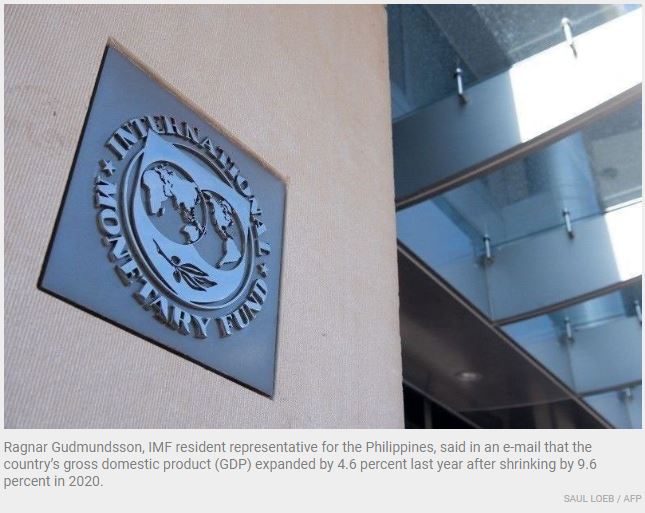IMF raises Philippine growth forecast for 2021
MANILA, Philippines — The International Monetary Fund (IMF) has hiked its economic growth forecast for the Philippines in 2021 and expects a return to pre-pandemic levels by the end of this year.
Ragnar Gudmundsson, IMF resident representative for the Philippines, said in an e-mail that the country’s gross domestic product (GDP) expanded by 4.6 percent last year after shrinking by 9.6 percent in 2020.
“The upward revision for 2021 reflects the better-than-expected outturn during the third quarter of 2021, which resulted from the successful implementation of more granular lockdowns and targeted mobility restrictions during the third wave of COVID?19,” Gudmundsson said.
Although this was faster than the IMF’s initial forecast of 3.2 percent for 2021, the expansion was lower than the revised growth target of five to 5.5 percent set by the Cabinet-level Development Budget Coordination Committee (DBCC).
“A continued reduction in the infection rate, fewer mobility restrictions and a higher vaccination rate helped sustain the recovery and growth momentum in the last quarter of 2021, despite the negative impact of Typhoon Odette,” Gudmundsson said.
The government placed the National Capital Region (NCR) and several provinces under Alert Level 3 as COVID-19 infections surged after the Christmas and New Year holidays due to the more contagious Omicron variant.
“Even though the rapid spread of the Omicron variant and new quarantine measures in the first quarter of 2022 are expected to slow the recovery, strong growth is nevertheless projected for the remainder of 2022, as vaccination proceeds further, policy measures remain appropriately supportive, and private sector confidence improves,” he said.
The IMF sees the country’s GDP growth accelerating to 6.3 percent this year, still lower than the seven to nine percent target set by economic managers, due to the carry-over from the upward revision of the 2021 expansion that is expected to be weighed down by the rise in COVID cases.
“Economic activity should return to pre-pandemic levels by the end of the year. Over the medium-term, we project GDP growth to pick up and stabilize at about 6.5 percent per year,” the IMF official said.
The multilateral lender expects the Bangko Sentral ng Pilipinas (BSP) to maintain an accommodative monetary policy stance this year as inflation is seen easing back to within the government’s two to four percent target range.
Inflation accelerated to a three-year high of 4.5 percent last year, from 2.6 percent in 2020, on the back of rising global oil prices amid the reopening from strict COVID-19 lockdowns, as well as elevated food prices in the domestic front due to higher food prices caused by supply shocks, including weather-related disturbances and African swine fever (ASF) outbreak.
The BSP sees inflation easing to 3.4 percent this year and 3.2 percent in 2023 as it vowed to keep a low interest rate regime to allow economic recovery to gain more traction.
The central bank has kept the benchmark rate at an all-time low of two percent for more than a year to encourage lending and boost economic activity.
“Monetary policy is expected to remain accommodative in 2022, which is appropriate given the manageable inflation outlook and the need to support the economic recovery,” Gudmundsson said.
According to Gudmundsson, the central bank should stand ready to tighten monetary policy if the rise in inflation observed last year becomes more entrenched as a result of higher commodity prices and supply-chain disruptions.
Another risk, he said, is the possible strong capital outflows and further depreciation of the peso due to the faster-than-expected tightening by the US Federal Reserve.
In a virtual forum, BSP Monetary Board private sector member Bruce Tolentino said there’s a lot of work that needs to be done to manage inflation amid pressure from higher commodity prices and projected deficits in domestic pork and fish supply.
Tolentino also cited the need to push research, technology and policy reforms to enable competitiveness in feed corn, livestock, poultry and fisheries as well as provide assistance for livestock and feed industries.
As food prices account for 47 percent of inflation, Tolentino stressed the need to review and streamline non-tariff barriers and constraints on agricultural products.
Source: https://www.philstar.com/business/2022/01/27/2156555/imf-raises-philippine-growth-forecast-2021


 Thailand
Thailand




